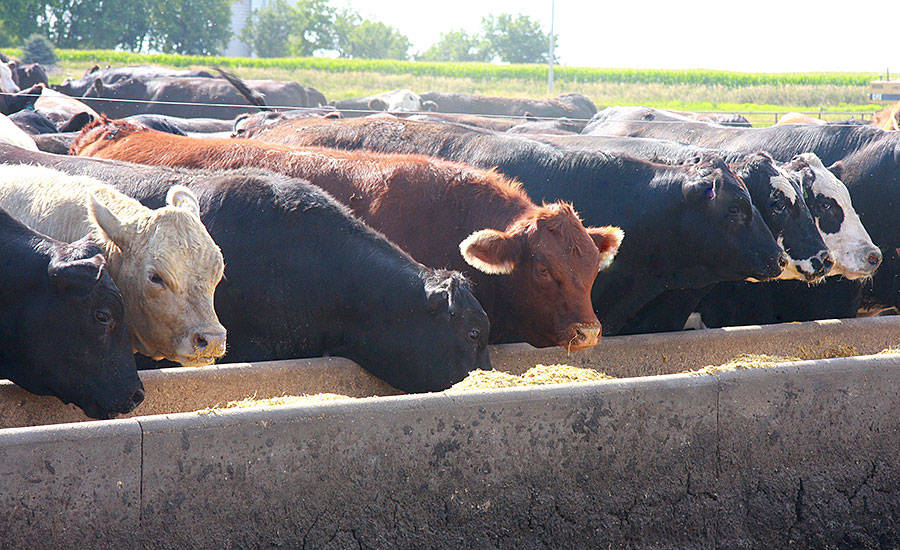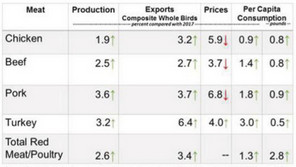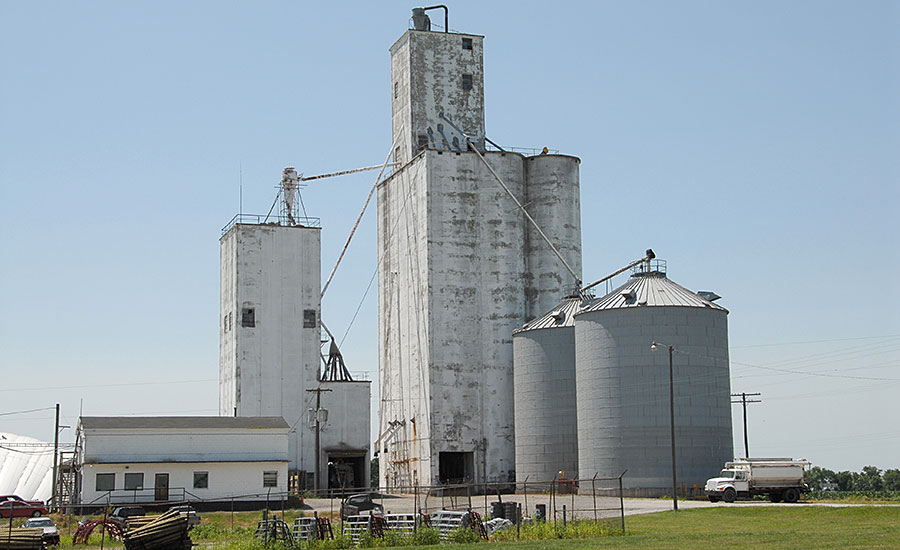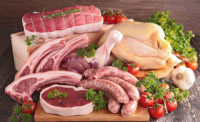Ask economists and industry analysts, and many of them will tell you 2017 very well may have been the best year the meat and poultry industries have ever had. Further, many have 2018 projected to be a successful follow-up to 2017’s chart-topping string of hits. The reason? Low feed costs coupled with strong domestic demand, rising prices and adequate supply created a profitable formula that is expected by those analysts to carry into 2018.
“The underlying factor is that grain costs are decreasing and stable,” says David Williams, vice president of Informa Economics IEG, Memphis, Tenn. “This allows feeding operations to create and follow a plan without price risks.”
Table of Contents
- Any black swans?
- Back-to-back profitability
- Investing in the future
- Heading in the right direction
- Returning to normal
- Optimism versus uncertainty
Livestock and poultry producers continued to benefit from inexpensive feedstuffs, such as soybeans costing roughly $9.50 to $10 a bushel, corn at $3.50 a bushel and meal at $300 a ton, he says.
“The animal feed business continues to be profitable and stable, which will springboard the meat industry to continued profitability in 2018,” Williams says.
In 2017, red meat and poultry supplies increased by 3 billion pounds compared with 2016.
“That increase in total supplies was expected to push market prices for all livestock supplies,” says Scott Brown, Ph.D., assistant extension professor, agricultural and applied economics at University of Missouri, Columbia, Mo. “Yet, with the exception of turkey prices, 2017 will finish with livestock prices higher or at least unchanged for 2017.”
So, 2018 looks to be a repeat of 2017 because the same general conditions of low risks exist with a modest increase in price pressure due to growing supply (specifically, 99.9 billion pounds in 2017 is projected to reach 102.7 billion pounds in 2018), says Derrell Peel, Ph.D., livestock marketing specialist, Oklahoma State University, in Stillwater, Okla.
Also it doesn’t hurt that domestic demand is strong, gas prices have moderated a bit — which affects discretionary spending — income is slowly growing and unemployment is low, Peel notes.
“Internal conditions are stable,” he says. “They’re growing but not out of balance. There is nothing the markets need to fix because everything is relatively stable.”
Any black swans?
“The greatest risk will come from external factors like a global economic upheaval, change in U.S. macroeconomics, trade policy or U.S. policy in general and the uncertainty that goes with it,” Peel says. “The industry should be aware that anything can happen and have a huge impact. But international stability is a reason for optimism in the meat industry.”
Back-to-back profitability

Beef had its best year — or at least one of its best years ever — with most plants making more than $100 a head in profit, Williams says. Feeder cattle made $30 to $80 a head, up to even $150 per head.
“From the U.S. and export standpoint, demand has only increased and gone higher. It’s an outstanding market for the beef industry,” Williams says.
The cattle-feeding sector did much better than anticipated with strong profits in 2017.
“Cattle prices were much higher than expected, even though supplies continued to increase cyclically,” says James G. Robb, director, Livestock Marketing Information Center, in Lakewood, Colo. “Strong demand for slaughter cattle pulled animals through feedlots, keeping animal weights in check.”
Domestic and international demand for red meat increased in 2017, and total beef production kept pace with a 2.7 percent increase (which is also predicted for 2018), Peel says. As total beef supply increases, the U.S. should import less beef next year. In fact, imports are already down 5 percent this year, he says.
“For only the fourth time in the last two decades, domestic meat availability increased and at the same time meat prices also increased,” Brown says. “Strong domestic demand is responsible for that outcome. As the general economy has grown in terms of jobs and income, it has translated into strong demand.”
Consumers seem willing to pay even more for higher-quality meat products, he says.
“Retailers and restaurants used beef, and also other meats and chicken, as features and specials to attract consumers,” Robb says. “Even though the U.S. economy was robust, competition for customers was aggressive, and the meat case was a focal point of that competition.”
International demand has also been impressive in 2017, Brown says.
“Meat exports are going to end the year up about 1 billion pounds,” he says.
The beef market has seen market fluctuations since 2014 because of rising prices and a strong dollar. “Generally, there has been strong global demand despite lingering effects from previous gyrations,” Peel says. “Beef exports are up 14.5 percent, pork increased 8 percent and poultry improved 1.4 percent after performing better earlier in the year, and broiler is up but less than the other meats, year to date.”
Red meat and poultry supplies look to be on target to expand another 3 billion pounds in 2018, but not necessarily from international markets, Brown says. Although opportunities for meat exports will probably grow in 2018, competition will increase from other countries as their supplies are also expected to increase.
If the U.S. economy continues to grow in 2018 as it did in 2017, domestic demand for meat should remain positive, Brown says.
“However, we have rarely had back-to-back years of higher meat consumption and higher meat prices,” Brown says. “Perhaps 2018 will be one of those repeat years.”
Investing in the future
Hog producers had a good year, too, Robb says.
“In fact, most should post record profits,” he says. “The big story late in the year was the new hog-packing plants beginning operations, which reduced margins for packers; still, they remained quite profitable.”
Hog farmers made an average of $20 to $30 a head this year, Williams says.
“Packers had their second best year in history, as well,” he says. “The pork industry has been in a good position for the first three quarters of 2017 with additional pork production destined for foreign markets.”
Also strong demand for further-processed pork such as ham and bacon still exists, Williams says.
“Retail grocery volume is approximately 70 percent fresh and 30 percent processed,” says Patrick Fleming, director of market intelligence, National Pork Board, Des Moines, Iowa. “Yet in foodservice — which for the first time surpassed retail sales volume of pork — it is the reverse with 30 percent fresh and 70 percent processed. Clearly, there cannot be a ‘one-size-fits-all’ approach to marketing.”
Creating consumer demand delivers value to the supply chain, he adds.
“For mid-tier consumers, pork loins are a great premium cut option,” Fleming says. “From the rack of pork to the boneless roast, the pork loin offers retailers versatility in merchandising.”
An increasing percentage of pork’s growth in 2017 has been exported, so Williams says any hiccups in business or sales (because of NAFTA changes, China or Mexico) really affect the profitability of pork as well as other meats.
Mid-year pork exports were disappointing, however, says Robb, as Chinese hog slaughter increased, limiting their pork imports and competition with European Union pork remained fierce.

Prices: 2017 and 2018 mid-points for composite whole birds, steers, barrows/grits, and 8-16 pounds hens. Source: USDA/WASDE August 2017
“Overall, the byproduct [items such as liver, tallows, hides/skins, etc.] markets were rather stagnate in 2017, which was surprising given the strengthening worldwide economic situation — foreign markets drive prices of those products,” Robb says.
U.S. supplies of pork — and beef and chicken — will all increase again in 2018, he says. The question is how much of that increase will export markets absorb?
“Profitability in the beef and pork processing sectors should allow additional investments in technology, automation and robotics in 2018,” Robb says.
Heading in the right direction
The chicken sector performed well the first three quarters of the year, but exports were disappointing, Robb says.
“In the second half, burdensome supplies began to pressure wholesale prices, especially for the breast products,” he says.
Overall, however, 2017 was a profitable year for the broiler industry, as chickens sold for $2 to $3 a head, Williams says. Retail and foodservice demand for chicken remained strong, coupled with ample feed and moderate corn and soybean meal prices, says Tom Super, vice president of communications at the National Chicken Council, based in Washington, D.C.
“Barring a disruptive event, 2018 should be another good year for chicken producers/processors,” Super adds. “With the production increase in 2018 most likely matching the pace in 2017 and 2016, one of the basic fundamentals determining the outlook appears to be somewhat given.”
To that end, the U.S. Department of Agriculture (USDA) forecasts broiler production in 2018 to be about 2 percent more than 2017.
“Per-capita U.S. chicken consumption remains at an all-time high and will increase almost one pound in 2018, getting close to 93 pounds per person,” Super says.
Many producers are making an effort to provide value-added and specialty items, but they are at the whim of the market, says Zain Akbari, equity analyst, Morningstar, based in Chicago.
“As consumers try to eat more fresh protein items, it leaves room for companies to innovate and reach new channels,” he says. “Even under the umbrella of value-added though, processed product can still be affected by the commodities market, despite contracts that are less risky today.”

One ongoing challenge this year was the slippage between weekly eggs being set for hatching (3 percent more) and the resulting day-old chicks available to be placed on growout farms (only 2 percent more), Super says.
“Among the reasons suggested [by analysts] are the changed genetics of the breeder hens, the age of the hatchery supply flock and the measurable shift away from using antibiotics in breeder flocks and in the hatchery,” Super says.
Export demand for chicken, while improving, could be better. “USDA does not forecast record chicken exports in 2018, but the direction is positive,” Super says. “China still has in place a ban on all U.S. poultry products stemming from the 2015 [highly pathogenic] avian influenza outbreak in layers and turkeys.”
Returning to normal
The turkey sector had a very difficult year as domestic demand for these products (whole birds and breast products) was very weak even as prices dropped, Robb says. Turkey producers struggled, as most of the year was not profitable, except (as projected) November and December during the holiday season.
“The industry over-expanded and the demand did not catch up with production,” Williams says. “We forecast continued struggles for the first three quarters of next year, as well.”
The industry is still feeling the effects of 2015’s avian influenza outbreak, which only affected 3 percent of product, according to Joel Brandenberger, president, National Turkey Federation, based in Washington, D.C., but disrupted domestic and international markets to a much greater degree.
“It was a challenging year for the turkey industry, and has been an unpredictable roller coaster for the last three years,” he says. “It will take 2018 to return to normal.”
The lost birds also caused prices to rise, he says, though breast prices eventually stabilized.
“Normal production resumed in 2016, but there’s been a significant decrease in the export market because so many countries banned U.S. turkey because of the avian influenza outbreak — save regional or county distinctions, such as in Mexico,” Brandenberger explains. China’s ban on U.S. turkey exports hasn’t been lifted yet, he notes.
“We’re mindful that even when China opens, the market won’t be around pre-2015 levels,” Brandenberger says. Domestic production is steady, but the loss of the export market had a notable impact on the industry.
Some positive signs are increased awareness among existing and new customers, with new items such as Smash Burger’s turkey burger, for example, and more upscale chains adding turkey items.
“2018 will be a stabilizing year, and we’ll start moving more in the direction we want by building on what we’re already doing in foodservice and retail. We know where opportunities are and where to be careful and watch out as we move forward,” Brandenberger says.
Optimism versus uncertainty
Labor remains one of the biggest challenges facing the meat industry due to heightened attention on employees’ legal documentation since President Donald Trump took office, Williams says.
“It’s gotten better the last few months, but labor availability has seen a big struggle at meat-processing, packinghouses and further-processing plants,” he says.
Trade policy in the Trump era is also a source of uncertainty, Peel says.
“We pulled out of [the Trans-Pacific Partnership], which is an opportunity we will never have now,” he says. “NAFTA is also very important to the beef, pork and poultry industries because we export a lot to Mexico, Canada and import as well. There’s uncertainty now — a black cloud hanging over the industry — which has an effect on the market.”
Global demand for protein is growing, and exports play an ever more critical role.
“It is estimated that the global middle class will increase 71 percent from 2016 levels,” Super says. “Population growth and urbanization boost demand, with most of that growth taking place in developing countries. With a little more money in their pockets, the middle class will look to more protein options, and U.S. chicken is poised to provide it to them.”
It’s possible strong market conditions will lead the industry to overshoot and oversupply.
“But on the whole, it’s a rather good time to be a protein producer and will stay that way,” Akbari says. NP





Report Abusive Comment